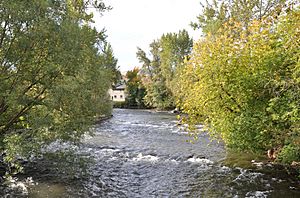Wallowa River facts for kids
Quick facts for kids Wallowa River |
|
|---|---|

Wallowa River at Wallowa, Oregon
|
|
|
Location of the mouth of the Wallowa River in Oregon
|
|
| Country | United States |
| State | Oregon |
| County | Wallowa and Union |
| Physical characteristics | |
| Main source | Confluence of the east and west forks of the Wallowa River about 1 mile (1.6 km) south of Wallowa Lake, Wallowa County, Oregon 4,499 ft (1,371 m) 45°16′28″N 117°12′42″W / 45.27444°N 117.21167°W |
| River mouth | Grande Ronde River Union County, Oregon 2,316 ft (706 m) 45°43′31″N 117°47′09″W / 45.72528°N 117.78583°W |
| Length | 55 mi (89 km) |
| Basin features | |
| Basin size | 950 sq mi (2,500 km2) |
| Tributaries |
|
| Type: | Recreational |
| Designated: | July 23, 1996 |
The Wallowa River is a river in northeastern Oregon, United States. It flows for about 55 miles (89 km) and is a branch of the Grande Ronde River. The Wallowa River helps drain a large valley on the Columbia Plateau, which is a high, flat area in the northeast part of Oregon.
Contents
About the Wallowa River
The Wallowa River starts where its two main branches, the East Fork and West Fork, meet. These branches begin in the Eagle Cap Wilderness, a wild area within the Wallowa–Whitman National Forest.
Where Does It Flow?
The river generally flows northwest through the beautiful Wallowa Valley. It passes by several towns like Joseph, Enterprise, and Wallowa. Along its journey, it gets water from other rivers, including the Minam River. Finally, about 10 miles (16 km) north of Elgin, the Wallowa River joins the larger Grande Ronde River.
History with the Nez Perce Tribe
The Wallowa Valley was once the home of the Nez Perce Tribe, led by Chief Joseph. The Nez Perce people had lived there for a very long time. In 1871, when the first white settlers arrived, Chief Joseph asked them to leave.
However, in 1877, the U.S. government forced the Nez Perce tribe to leave their homeland. Their property and livestock were taken, as other farmers and ranchers wanted to settle in the fertile Wallowa Valley. Even after asking many times, the tribe was not allowed to return to their home. Instead, they were moved far away to a new territory, which is now Oklahoma.
Fish in the Wallowa River
The Wallowa River is home to several types of fish. You can find steelhead, which are a kind of rainbow trout, and spring Chinook salmon. Another fish found here is the mountain whitefish.
Sadly, Sockeye salmon used to live in the Wallowa River but are no longer found there. This happened after a small dam was built at the start of the river, near Wallowa Lake. The dam was built to raise the lake's water level, so the water could be used for farming. This dam blocked the sockeye salmon from reaching their spawning grounds.


